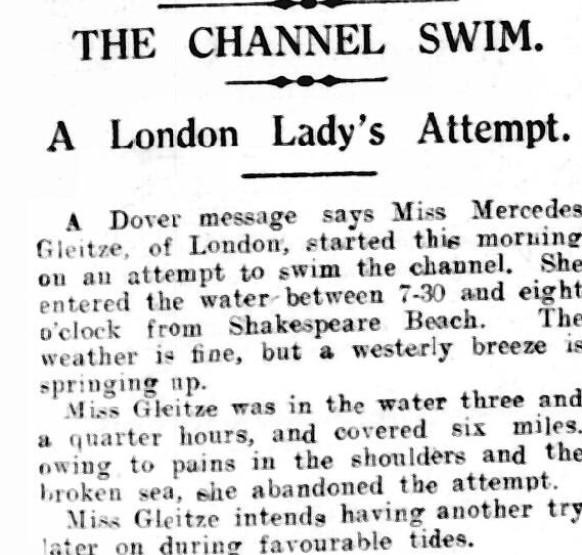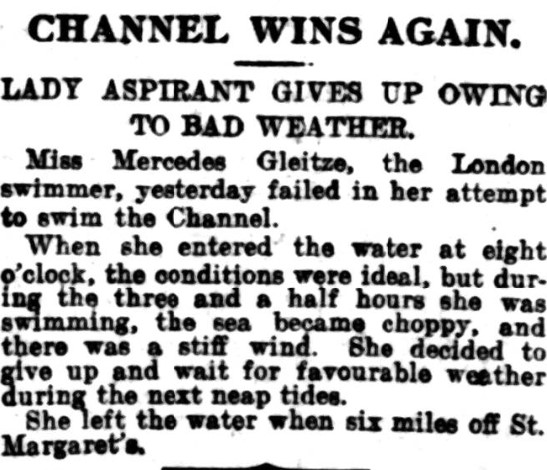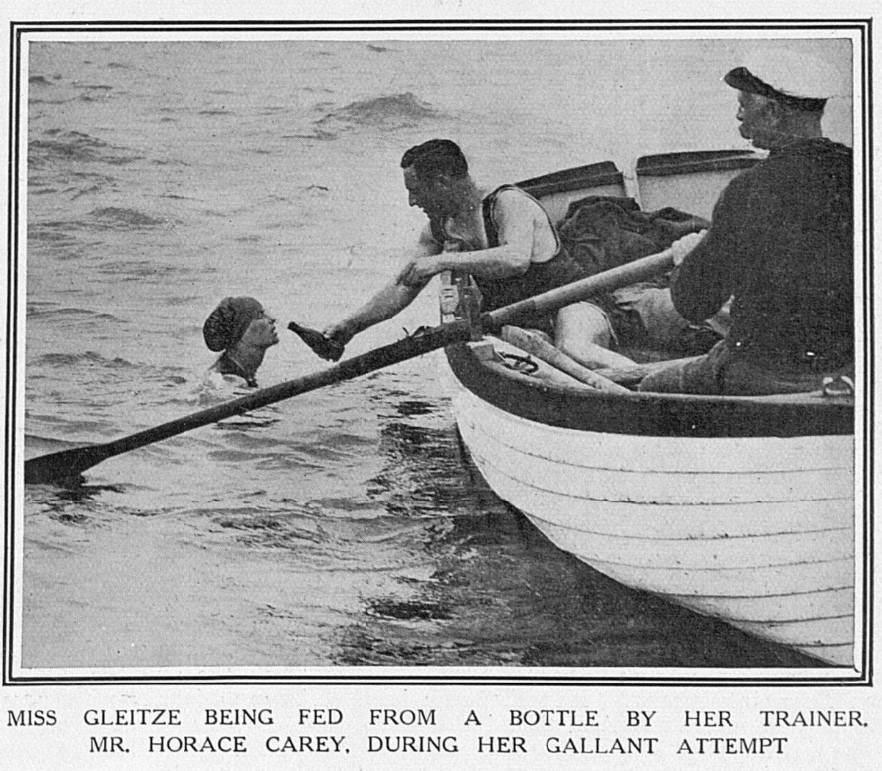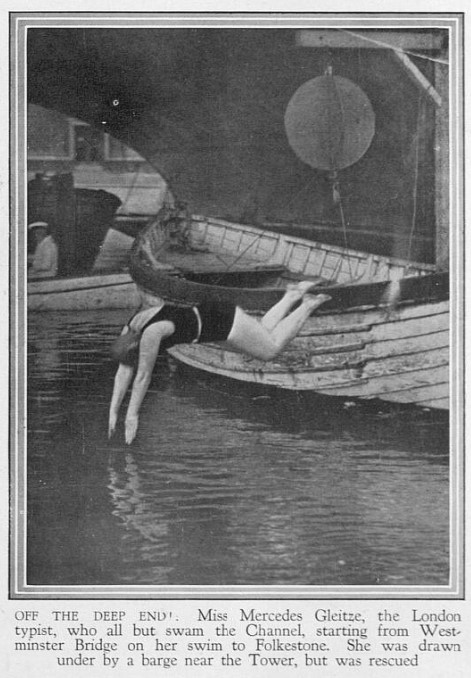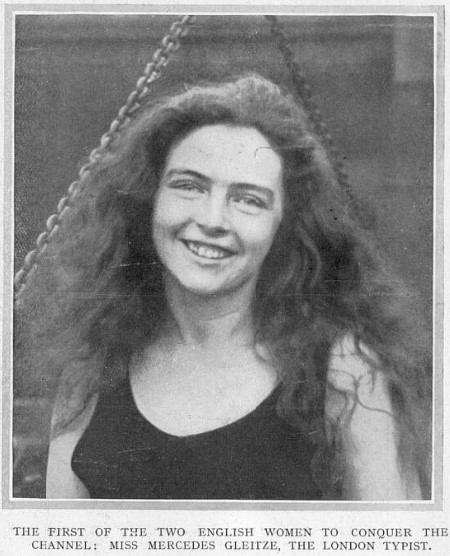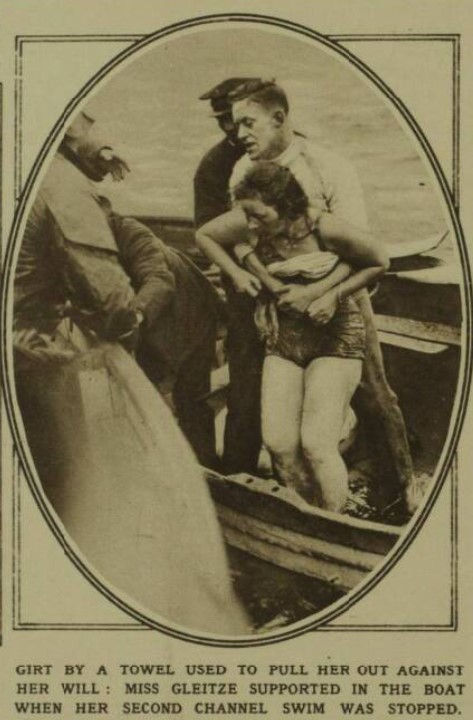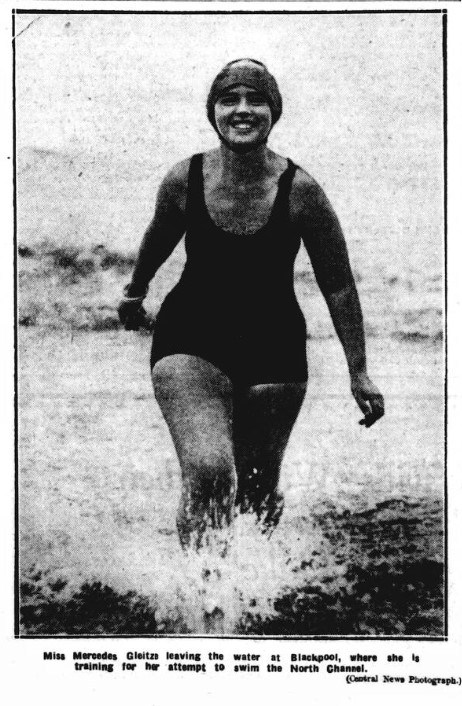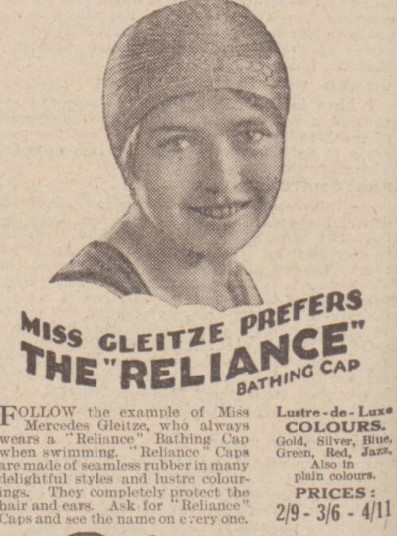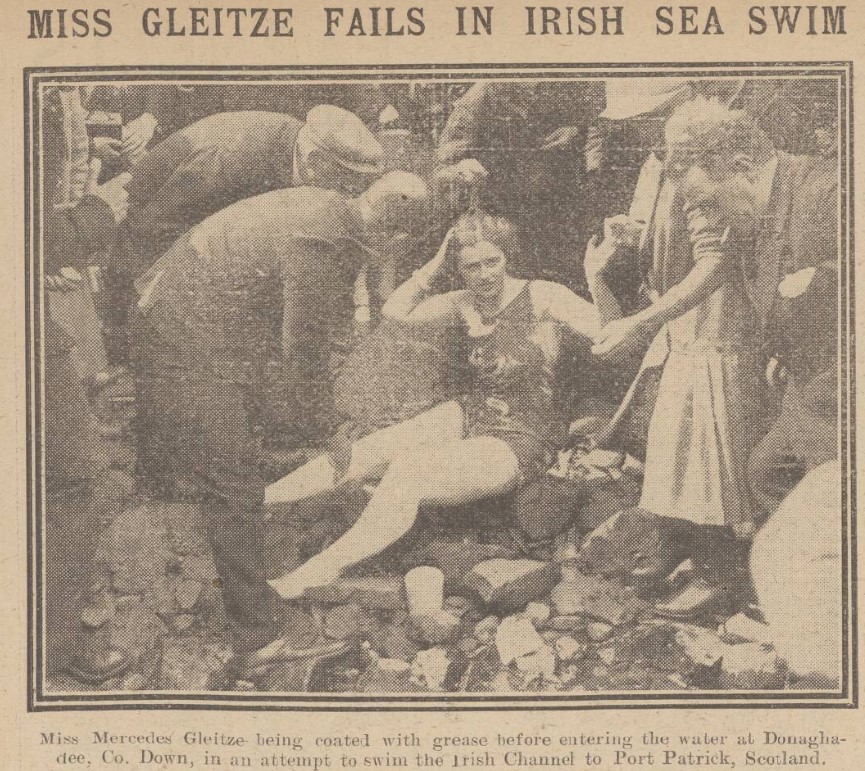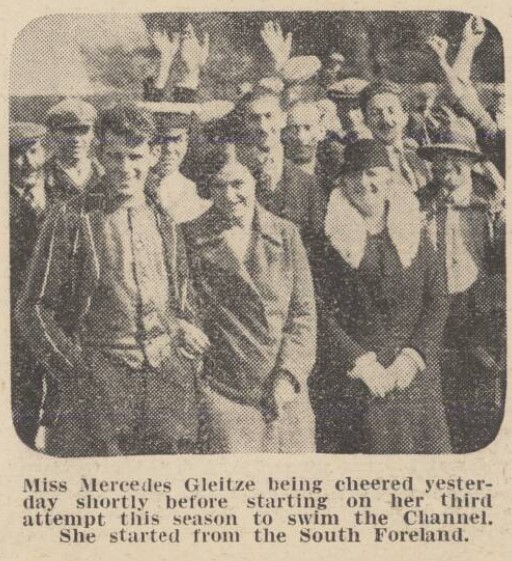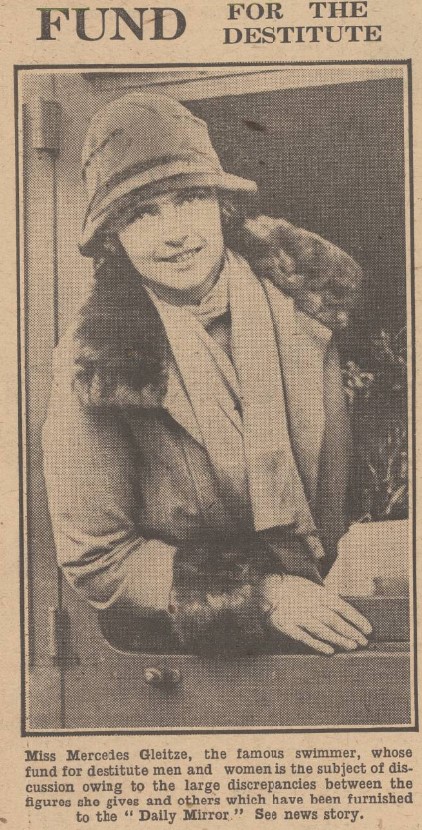Mercedes Gleitze (1900-1981) was the first British woman to swim the English Channel, and the first person to swim the Straits of Gibraltar. In an amazing career that spanned the 1920s and 1930s, Mercedes captured the imagination of the British public and became a household name.
Born to German parents in Brighton, Mercedes was one of three sisters. Skilled in languages, she moved to London where she worked as a secretary and stenographer. Whilst living in London she began swimming in the Thames, and her passion for endurance swimming was sparked.
In this special blog, using our newspapers, we will explore the amazing swimming career of Mercedes Gleitze, tracing the highs and the lows of her remarkable life.
‘A London Lady’s Attempt’
One of the earliest mentions we could find in The Archive of Mercedes Gleitze comes from the Hartlepool Northern Daily Mail on 3 August 1922. The short piece detailed a ‘London Lady’s Attempt’ to swim the Channel. This was Mercedes’s first attempt to swim the stretch of water, and the Hartlepool Northern Daily Mail described how she ‘entered the water between 7.30 and eight o’clock from Shakespeare Beach,’ Dover.
It was a promising day for the attempt, the weather being fine, although a ‘westerly breeze’ was observed to be ‘springing up.’ However, the endeavour was not destined to be a success, the newspaper reporting how:
Miss Gleitze was in the water three and a quarter hours, and covered six miles, owing to pains in the shoulders and the broken sea, she abandoned the attempt. Miss Gleitze intends having another try later on during favourable tides.
But the swimmer, then aged only 21, was back in the news only a few days later, the below piece appearing in the Dundee Evening Telegraph:
In an attempt to break the women’s record for river swimming Miss Mercedes Gleitze swam in the Thames for seven hours and seven minutes, covering about 19 miles. The record is 20 miles in 10 hours 17 ½ mins, swum by Miss Eileen Lee.
‘Typist Attacks Channel’
In 1926 Mercedes Gleitze continued with her quest to complete the Channel crossing. On 26 July 1926 the Scotsman detailed how her attempt that month had failed, ‘after five hours’ battling with the choppy seas.’ In this attempt, Mercedes had covered ‘altogether 19 miles,’ setting out from the beach at Folkestone and being accompanied ‘by her trainer and a lady doctor, who swam with her for three hours.’
Despite the failure of this attempt, both Mercedes’s name and picture appeared more and more in the press, as the British public became fascinated by her aquatic endeavours. On 31 July 1926 in a spread entitled ‘Bathing Season Begins,’ The Sphere pictured Mercedes swimming in the Channel, as she was ‘fed from a bottle by her trainer Mr. Horace Carey.’
Moreover, The Sphere detailed how ‘vast crowds of holiday-makers gave her a rousing send-off from Folkestone,’ with the doctor who swam with her ‘singing songs while she was in the water.’ The publication deemed her attempt as a ‘gallant but unsuccessful’ one. It was, furthermore, noted that the swimmer was hindered by rough seas, which even drenched those in the accompanying boat, and that Mercedes ‘was persuaded to leave the water, much against her will.’
By September 1926 Mercedes Gleitze was trying again, London’s Weekly Dispatch reporting how on the morning of 19 September the ‘London typist’ was again ‘attacking the channel.’ This was her third attempt of the summer, in splendid weather. It was, however, not destined to be a successful one.
More Attempts
Mercedes Gleitze was unperturbed, and did not let these failures hold her back. As 1927 dawned she took on new challenges, The Sphere on 30 July 1927 picturing the swimmer at the start of her journey from Westminster Bridge to Folkestone, during which she ‘was drawn under by a barge’ near the Tower of London, but thankfully rescued.
More attempts to swim the Channel were on the cards, and on 29 September 1927 the Sheffield Independent was reporting how the ‘bold typist’ had been ‘foiled’ on what was believed to be her fifth attempt (it was indeed her sixth) to swim the stretch of sea between England and France.
The newspaper detailed how Mercedes had, this time, been eight hours in the water, and was sixteen miles clear of Cap Gris-Nez, the point on the French coast from where she had set out. Her performance was regarded as an ‘extremely creditable one,’ with experts believing that her failure had stemmed from ‘the lateness of the season and the consequent coldness of the water.’
Mercedes was not put off, however. Her seventh attempt soon followed, but again ended in failure. The Leeds Mercury on 6 October 1927 reported how Mercedes had been in the water for nine hours, when the ‘weather and tides caused the abandonment of the swim, which commenced very favourably.’
The Leeds Mercury detailed how Mercedes Gleitze’s trainer was impressed by her effort, as he described how it was ‘the finest swim she has ever done. The waves were breaking in her face for five and a half hours, and it was impossible for anybody to continue in it.’
Success At Last
But soon Mercedes Gleitze’s ‘pluck and perseverance’ would win her the prize of her first successful swim across the English Channel. The Sphere on 15 October 1927 pictured ‘Personalities in the News,’ one of whom was Mercedes Gleitze, who was credited as being ‘the first Englishwoman to swim the channel,’ having succeeded on her eighth attempt.
It had taken her 15 hours and 15 minutes to swim the stretch of water, and The Sphere pictured her with Captain H. Sharp, ‘who piloted her during her triumphant crossing.’
The aftermath of her success was not destined to be plain sailing, however. On the same day the Illustrated Sporting and Dramatic News described Mercedes Gleitze as being ‘the first of the two English women to conquer the channel,’ the other being Dr. Dorothy Cochrane Logan, who had completed the feat in the much quicker time of 13 hours and 10 minutes.
But as detailed by the Sheffield Daily Telegraph in April 1928, Dr. Logan’s claims were in fact a ‘hoax,’ something to which she later confessed. And yet, because Mercedes Gleitze’s successful channel swim of 7 October 1927 was not ‘officially attested,’ ‘some doubt’ was then cast on her claims by Dr. Logan’s confession.
This meant that Mercedes had to undertake a vindication swim on 22 October 1927, this time in ‘icy water.’ The Sheffield Daily Telegraph reported how the accompanying boat was, this time, ‘manned by Pressman and official witnesses.’ After swimming for ten hours, Mercedes had to be ‘taken out of the water, when a little over five miles from Dover.’ This valiant attempt, however, solidified her credibility, and Mercedes Gleitze was acknowledged as the first British woman to have swum the Channel.
Another Challenge
Not satisfied with having completed her aim of swimming the English Channel, Mercedes Gleitze soon turned her eyes to fresh challenges, and focussed her attention on the Straits of Gibraltar.
On 7 April 1928 the Sheffield Daily Telegraph describes her success, after ‘nearly thirteen hours’ of swimming, and ‘many failures.’ The newspaper continues to describe her as ‘the plucky London typist,’ despite her proven track record of swimming achievements.
Mercedes had entered the water at 7.50 am at Tarifa, Spain, landing at Punta Leona, ‘the northernmost point of Morocco at 8.40 at night,’ her swim having lasted 12 hours and 50 minutes. This was her sixth attempt to swim the Straits of Gibraltar, her first having been made in December 1927, with others following in January, March and April 1928. An attempt on 25 January 1928 saw the swimmer nearly being drowned, having been ‘caught in a whirlpool.’
The swim, according to the Sheffield Daily Telegraph, was a tough one, Mercedes herself being recorded as saying:
‘Many times…I thought of giving up the attempt, but, following the advice of the pilots who accompanied me, I continued to struggle, and finally arrived in Morocco.’
Circuses and Swimming Baths
Following her successful swims across both the English Channel and the Straits of Gibraltar Mercedes Gleitze was in high demand. The Fleetwood Chronicle on 11 May 1928 reported how the swimmer had ‘entered into a twenty weeks’ contract to appear at the Tower Circus, Blackpool.’ Appearing twice a day, in the afternoon and evening, Mercedes would also provide ‘practical demonstrations of the manner in which she carried out her long-distance swims.’
Despite providing such entertainment in Blackpool, Mercedes Gleitze also aimed to swim across the Irish Sea. The Fleetwood Chronicle described how her Tower Circus contract allowed her ‘two days off towards the end of June, in order that she can make an attempt to swim the Irish Sea.’ After that, it was reported that she was set to meet the American endurance swimmer Lottie Schammeh in a competition in the United States, with £200 on offer should she win or lose, or £1,000 for every hour that she could ‘outstay her rival.’
Whilst unable to achieve the feat of crossing the inhospitable Irish Sea, Mercedes continued to break records. On 12 June 1930 the Belfast News-Letter reported how the swimmer had ‘broken her own endurance record,’ which stood at 36 hours, by swimming for 37 hours in the ‘baths at Douglas, Isle of Man.’ After that, she was set to swim around the Isle of Man, a distance of 85 miles, something Mercedes believed she could accomplish in four days.
In Her Own Words
A few weeks later, on 26 June 1930, the Skegness Standard printed an article penned by Mercedes Gleitze herself, which was entitled ‘Long Distance Swimming – Is It Easy?’ She began the piece by addressing the four unsuccessful attempts she had made to swim the Irish Sea, across the North Channel, in 1928 and 1929, paying testament to the ‘support of [the] Irish people’ who turned out in their thousands to watch her set off, many taking to boats to watch her progress.
She described one occasion where she had been swimming for a total of 14 hours and 50 minutes. Her end point, Portpatrick, a village in Scotland, was five miles away. However, Mercedes’s doctor gave orders that she be removed from the water, despite her protestations that she would rather continue. Indeed, the swimmer had to be removed from the water by the doctor and two fishermen. Mercedes relates what happened next:
They carried me to the cabin where I lay for at least an hour in a semi-conscious condition – just moaning with pain caused by the returning circulation; my doctor and lady attendants who had spent the time dripping towels into boiling water and wrapping them round my limbs and shoulders to make me warm, were getting desperate and I heard the doctor’s voice appealingly shout, ‘Miss Gleitze, speak to us, speak to us, you are not swimming now, it is all over,’ but I was too paralyzed to talk.
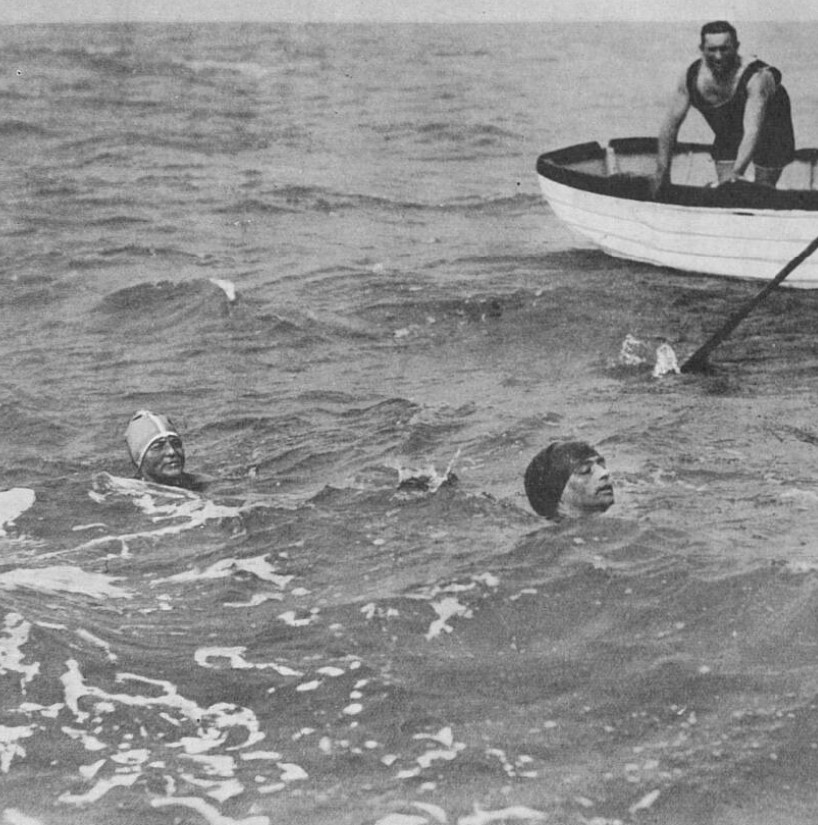
Mercedes then reflected on the qualities one needed to be an endurance swimmer: stamina, strength, endurance, and a ‘strong and healthy constitution.’ But above all one needed will-power. In a vivid passage Mercedes captured exactly what it meant to be a endurance swimmer taking on the ocean:
Another important factor is will power – the will to endure the cold – to put up with the discomfort of choppy waves – to ignore the sting of jelly fish – to be disconcerned at the nearness of porpoises, dolphins and even sharks – to bear the pain of aching shoulder, knee and shin muscles – to remain floating in the water with your arm or leg seized with cramp, allows you to swim – to remain unperturbed when a large steamer having passed too near causes a nasty wash and a series of mountainous waves jostle you up and down – to bear up when you cannot have the hot drinks you asked for, longed for and sorely need, a raging gale having put the ‘kitchen’ out of function by upsetting the stove and spilling the food – not to be upset if the goggles ‘go wrong,’ but to slide them off the head and take the force of the spray – not to become dejected if every witness is laid out on the deck a victim of seasickness – to fight for consciousness when an attack of sleepiness threatens to send you to the land of oblivion and last but not least to have the courage to say ‘I want to carry on’ when asked to give up, though every part of your body may be aching and you have spent endless hours visualising blankets and hot water bottles and been positively longing for a lie-down on ‘terra firma.’
Marriage
In August 1930 Mercedes Gleitze took some time out from her hectic schedule to be married. The Gloucester Citizen on 9 August 1930 described how the swimmer was married on that very day at St. Paul’s Roman Catholic church in Dover to Patrick Carey, a ‘young Dublin engineer.’ She wore a ‘long white sleeveless silk dress, trimmed with silver tulle,’ and her bridesmaids were, fittingly, American twins Bernice and Phyllis Zittenfield, who were in training to swim the English Channel. Even more on theme, the twins wore ‘sea-green voile frocks.’
It was to be but a brief respite for Mercedes, who was due to travel to Constantinople (Istanbul) to swim the Hellespont, also known as the Dardanelles. The couple’s honeymoon would be taken in March, when they were set to travel to the Sahara Desert.
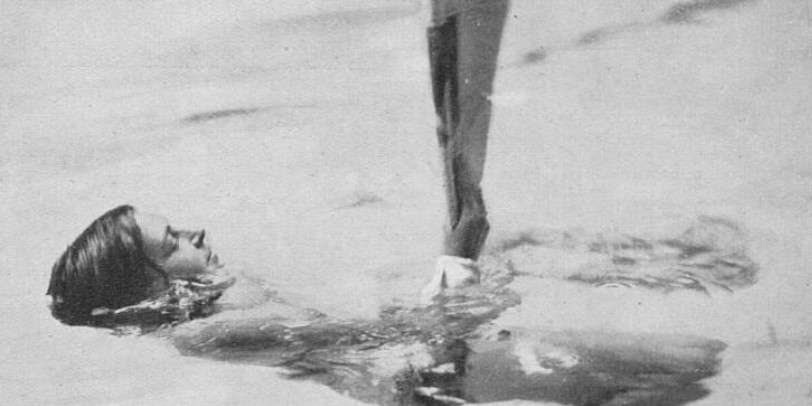
A few weeks later, the Leicester Evening Mail on 23 August 1930 was reporting how Mercedes was going to attempt to break her own endurance record once more, this time at the Cossington Street Baths in Leicester, on 11 September 1930. This swim was anticipated to last 40 hours.
More Records
By 1932 Mercedes Gleitze was breaking her own records once again. The Eckington, Woodhouse and Staveley Express on 23 January 1932 described how a ‘crowded audience’ at the Chesterfield Central School Baths ‘saw Miss Mercedes Gleitze set up a new endurance record of 45 ½ hours’ continuous swimming.’ This had broken her previous record of 45 hours, which she had completed at Rotherham.
Meanwhile, in March 1932 Mercedes travelled to South Africa to break yet another record. The Leeds Mercury on 28 March 1932 printed the following message from Cape Town:
Miss Mercedes Gleitze, the well-known Channel island swimmer, swam from Robben Island, in the Table Bay, to Cape Town in 7 hours 35 minutes on Saturday, thereby breaking the record.
But the English Channel, the stretch of water that had made Mercedes’s name, still proved a lure for the swimmer. On 2 August 1933 the Belfast News-Letter was reporting how Mercedes Gleitze was attempting yet another crossing of the Channel. She was set to enter the water at 10am at the South Foreland, Dover, accompanied by a boat, which would be piloted by Mr. Brockman. Also on board were to be four independent witnesses, as well as her husband Patrick Carey and Dr. McClean, her medical advisor.
After this swim, Mercedes retired. She had given birth to a daughter, Elizabeth, in 1932 and went on to have two more children, Doloranda and Fergus. Alongside her swimming, Mercedes embarked on charitable efforts, opening the Mercedes Gleitze Home in Leicester in 1933 for homeless families. She went on to found several more of these so-called ‘Gleitze Homes’, some of which were used to house homeless Czech families in 1939. The Mercedes Gleitze charity is now linked with Family Action.
Legacy
Her legacy was set to live on in a very different way too: in a Rolex watch. For many years, Rolex has used Mercedes Gleitze’s achievements to advertise their waterproof watch, the Rolex Oyster. This is the copy from a November 1950 advert, which appeared in The Tatler:
Here is the Rolex Oyster, first and most famous waterproof wrist-watch in the world. How was such a watch made a reality? It was the result of years of experiment by Rolex technicians. Imagine their excitement when, in 1927, Miss Mercedes Gleitze, a London stenographer, startled the world by swimming the English Channel wearing…a Rolex oyster!
But in spite of such ties, Mercedes Gleitze shunned the limelight in her later years, not telling friends and neighbours about her remarkable achievements. She passed away on 9 February 1981 in London, at the age of 80.
Find out more about Mercedes Gleitze, other inspiring women from history, and much more besides, in the pages of our Archive today.



